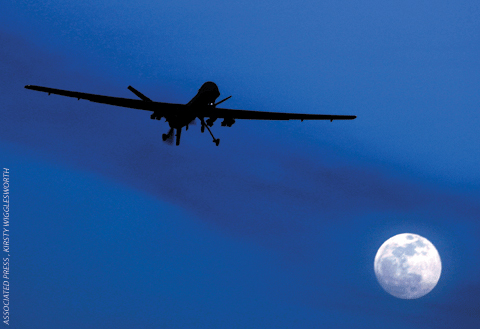
Hysteria, hype, and the long view of war.
By Charles G. Kels
The killing of Anwar al-Awlaki and a fellow American-born propagandist in late September was both a significant blow against al-Qaeda in the Arabian Peninsula, as well as a stark reminder of the increasing prevalence and strategic importance of drone strikes in the fight against terrorist networks.
Depending on whom you ask, the unmanned aerial vehicles that carry out such missions are either a lofty advancement in precision warfare or the death knell of chivalry and martial restraint. Perhaps not since nuclear warheads has a weapons system or platform been so hotly debated.
With nukes, the stated goal of possessing them has generally been notto have to employ them, which reveals widespread consensus that they are, at best, a necessary evil. Since they cannot accurately distinguish between combatants and non-combatants, the controversy surrounding them often pits the inhumanity of their use against the necessity of their availability. The utilization of drones, on the other hand, is very much a reality. What appears to be contested is their effects—both on the enemy and on us.
While the range of voices defies easy categorization, it is safe to say that much of the existential angst over drones emanates from academics in higher education and think tanks. Legal scholars often view the weaponization of unmanned vehicles as an invitation to use excessive force. (In particular, strikes against radicalized American citizens in the sovereign territory of foreign nations not currently “at war” with us raise a host of legal issues.) Political scientists worry that physical impunity will lower traditional barriers to waging war by undercutting the electorate’s personal stake in military adventures, and with it, the long-sought ideal of democratic peace. Social scientists of all stripes fret over the facelessness of virtual warfare, noting that a war-as-video-game construct is destructive of the soul and the psyche.
The scholarly gist is that drones are pernicious at both the personal and societal levels. Ironically, many scholars with an antimilitarist outlook at times appear to pine for the classical warrior, with blood on his sword rather than coordinates on his keyboard.
The political establishment is similarly fixated on drones—but for quite another reason. Simply put, politicos can’t get enough of them, for perhaps the same reasons the academy can’t stand them. In 2008, Defense Secretary Robert Gates took the Air Force to task for its reluctance to fully embrace pilotless vehicles, allegedly shortchanging battlefield needs. Just one year later, CIA Director Leon Panetta famously called drones “the only game in town.”
The academician-politician divide on the drone question may be best encapsulated by the evolution of Harold Koh, the Yale dean turned State Department legal adviser. In his distinguished scholarly career, Koh was an ever-vigilant watchdog on executive overreaching. In his role as political official, Koh contends that the White House did not require Congressional authorization to continue its Libya operations because they did not amount to “hostilities” under the War Powers Resolution. The linchpin in Koh’s argument was the minimal risk to American troops, whose lack of a ground presence made it impossible for Libyan forces “to exchange fire with them meaningfully.”
Koh insists that he never says anything he doesn’t believe, and his record of academic excellence and public service certainly entitles him to be taken at his word. But that doesn’t preclude the conclusion that Koh-the-appointee is currently advocating positions that Koh-the-scholar would likely have condemned. This may simply reflect the journey from the halls of learning to the halls of power. Harvard law professor Jack Goldsmith, who not too long ago completed a trip in the opposite direction, criticized Koh’s legal analysis for its slippery-slope implication that once the military “starts firing missiles from drones it is no longer in ‘hostilities.’”
The armed forces are conspicuously absent from the drama over drones. Those tasked with fighting the nation’s battles understand that the history of warfare—from the fist to the arrow to the fire-and-forget missile—is an eternal quest to obtain an asymmetric advantage. Drones, first as surveillance tools and more recently as weapons platforms, are another step along that continuum, and the technological edge they provide is probably as ephemeral as it is spectacular.
The immediate goal of any hostile engagement is to place the enemy in a position where he bears the brunt of the risk. Thus the capacity to exercise lethality outside the adversary’s weapons engagement zone is an excellent prescription for tactical success. The best fight is inherently an unfair one. To borrow the wisdom of General George Patton’s character in the eponymous biopic, “You don’t win the war by dying for your country. You win the war by making the other poor, dumb bastard die for his.”
From the war fighter’s perspective, drones are neither a panacea nor a curse, but rather a tool in the larger arsenal. As the theorist Nassim Taleb has noted, professional soldiers are comfortable with the concept of uncertainty because it is inherent to their business. Hence it is rare to hear a uniformed spokesman falling into the politician’s trap of heralding drones as perfect; no weapon is completely accurate, and it is a tragic fact of war that civilians will always suffer. Nor are you apt to hear an officer echoing a scholarly denunciation of drones as inherently inhumane; unless a weapon is specifically designed to inflict gratuitous pain or target innocents, then its morality is determined by how it is employed. The relevant threshold is not whether drones are good or bad, but whether in each particular scenario, our use of them is as or more discriminating than the alternative.
While the widespread deployment of armed drones is a relatively new phenomenon, the consternation over warfare from a distance has a much longer pedigree than GPS targeting technology. According to the military historian John Keegan, medieval knights like the Chevalier de Bayard responded to innovations in weaponry by summarily executing captured crossbowmen, “on the ground that their weapon was a cowardly one and their behavior treacherous.” Battles in which superior-equipped forces routed hapless armies—from the late-19th-century Battle of Omdurman, to Mutla Ridge in the Persian Gulf War—have often been remembered as equally tragic and triumphant.
Indeed, much of the media coverage of the recent NATO actions in Libya echoed the Kosovo campaign a dozen years earlier, in which cruise missiles were fired from high-altitude bombers, distant ships, and submarines. In both cases, remote warfare in defense of humanitarian imperatives proved apparently effective, even as the Western public appeared oddly disengaged. Even the presidential rhetoric exalting zero casualties was eerily familiar.
In many respects, drones have become a stand-in for a deeper, more fundamental debate. What scholars are truly rejecting, and what politicians are really embracing, are not drones per se, which after all help spare the lives of American troops. It is rather a political shift—conveniently coinciding with technological capabilities—in which wars are increasingly waged without galvanizing public support because little public sacrifice is sought or required. The temptation for policy makers to pursue military objectives without consulting the populace is obvious enough. The danger in this development, many commentators warn, is the erosion of our politics (a citizenry disengaged from its foreign policy) and our morals (a nation prepared to kill, but not die, for its values).
These fears are real and worth thinking about. But they should not delude us into assuming that drones will somehow alter the enduring nature of warfare, either in the manner that academics fear or politicians hope. War cannot be precisely calibrated or predicted because it is driven by the politics and psychology of its participants. As the soldier-historian General H.R. McMaster takes pains to remind us, the predicament posed by our technical prowess is not that it will revolutionize the intractable essence of warfare, but rather that it will seduce us into the dangerous conceit that we can fight the wars we envision, rather than those our enemies may mercilessly impose upon us.
Just as the logic of nuclear deterrence did not end conventional conflagrations, drones will not extinguish the human element of combat. Reflecting on ironclad Navy vessels, Nathaniel Hawthorne mused in 1862 that “human strife is to be transferred from the heart and personality of man into cunning contrivances of machinery, which by-and-by will fight out our wars with only the clank and smash of iron … damaging no one’s little finger except by accident.” Then came the escalating horrors of the Civil War, which prefigured the misery of the World War I trenches. More recently, the Pentagon’s top planners spent the better part of the 1990s and first part of the 2000s heralding a “revolution in military affairs” and all-knowing “system of systems” approach, only to undergo a dramatic recalibration when faced with the long, hard slog of two prolonged counterinsurgencies.
As it turns out, the most dangerous aspect of drones is not their payload of Hellfire missiles. It is instead the misconception they instill—in proponents and detractors alike—that war can ever be antiseptic and riskless, that there is such a thing as “drone warfare” at all. We can never discount the possibility that our technological wizardry, far from cowing or decapitating an overwhelmed foe, is merely communicating to our mortal enemies that we lack the resolve to see the fight through. The day that resolve is challenged by an enemy that meets our fleet of drones with one of its own, we will surely find that the source of our strength resides where it always has: in the unthinkable sacrifices that Americans are prepared to make in the nation’s defense.
Charles G. Kels L’03 is an attorney for the Department of Homeland Security and a major in the U.S. Air Force Reserve. Opinions expressed in this article are those of the author alone and do not necessarily reflect those of the Department of Homeland Security, Air Force, or Defense Department.




